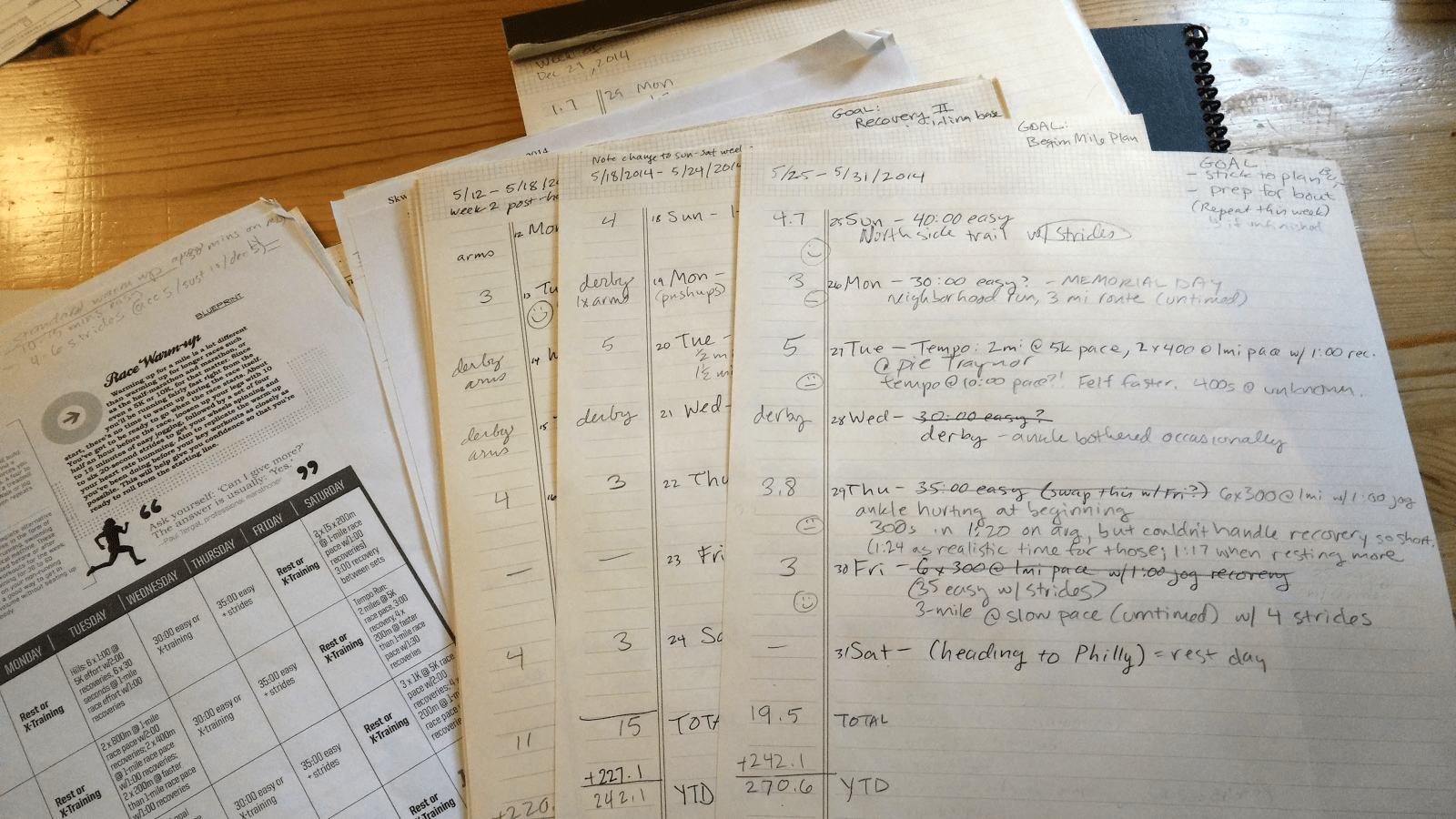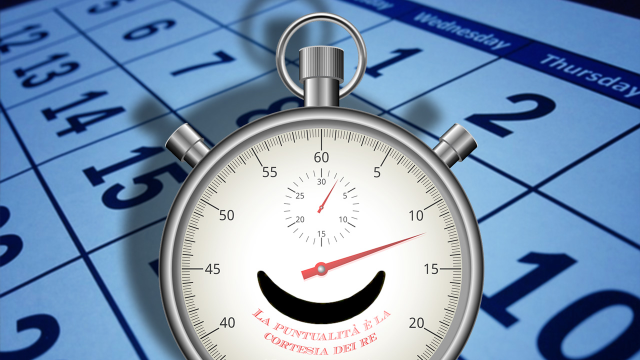Over 15 years of running, I’ve tracked my progress with clunky online logs, GPS-enabled watches, and smartphone apps. At first I geeked out over all the data, but now I’m back to where I began: with a wristwatch and a scrap of paper.
The rise of technology in running
When I started running. I would head out with a wristwatch and a folded-up printout of a beginner running program I had found on Runner’s World. When I got home, I would gulp a cold drink, take a quick shower, and enter the day’s run into an online log. It was 1999 or so, and I believe I was still using a 486.
A decade later, I borrowed a fantastic piece of technology from a friend: a gigantic watch that could tell you what pace you were running right now. It was amazing. I started marathon training that winter, and got a similar watch for Christmas: a Garmin 305. That thing was my best buddy: it told me how long I was running, how far, and how fast. It could track any splits or laps I asked it to. I could download my data after each run and see a map of where I had been! A chart listing my time for each mile! A graph showing exactly where I sped up or slowed down!
More time passed, and an even more wonderful thing happened: all of those features started showing up in smartphone apps — and, oh yeah, I got a smartphone. Now I could start up something like RunKeeper and have a robot lady tell me, at every mile, how fast I was running and how far I had left to go. If I wanted to follow a certain interval program, the robot lady could prompt me when to speed up and when to slow down. And at the end of the day, I could get the same data dump my high-tech watch used to give me, no charging cable needed.
And yet, the more serious I got about my running and about my athletic endeavours in general, the less I cared about the data dump. Most of those numbers didn’t help me train. Some were harmless distractions, but others tricked me into shifting my goals. For example, I bombed one race because I was focused on seeing the “right” numbers on my watch, when I should have paid more attention to how I was feeling.
How tech can interfere
Where there’s a number, there’s a temptation to “improve” it. Some lucky people can collect tons of data on themselves and use it judiciously, prioritising what matters and forgetting the rest. But some of us can’t find a happy medium between obsessing and ignoring. This can lead to taking inadvisable actions based on numbers (“I can totally get my calories down to 1000 tomorrow!”) or getting disappointed at the limits of humanity and physics (“Why didn’t I run this race as fast as the calculator predicted I could?”)
Take, for example, the average pace that apps commonly give you at the end of a run. Because it’s one of just three numbers the app uses to summarize your run (your app may vary) it becomes easy to assume that average pace is an important number that means something. You’ll be tempted to lower that number each time you go out, or at least to expect it to drop over time, right? But that mentality is the opposite of what will help you in the long term. Your slow runs should be slow, and the quality of your fast runs isn’t measured by a total that includes warmup and recovery time.
Instead, you should measure each run by the goal you’ve set for it, even if that isn’t something you can quantify. For easy runs, I focus on feeling relaxed and on simply putting in miles, like money in the bank. For intervals, the goal is to run a certain speed, but to do so consistently while keeping track of how those intervals felt. In truth, a lot of the feedback from your running workouts will be in terms of how it feels, not what numbers you clocked.
Which is why all those graphs and charts can interfere. We have good days and bad days; we get injured and recover. We hope and long for improvement. And all of these tendencies make it easy for data dumps to disappoint us: They shove in our face how “slow” we are, or enable us to find other faults. On the flip side, we might be happy to see any improvement in numbers, which is useless without a reality check: Are those numbers the right ones to focus on?
My low-tech tool #1: Pencil and paper
While I haven’t completely ditched tech, I rely on it far less than I used to. My measurement tools of choice are a wristwatch (with a stopwatch function) and a paper-and-pencil notebook that I keep at home.
My process starts with setting goals and deciding what numbers are worth tracking. If you’re not monitoring progress toward a goal, there’s no point to tracking anything at all. I break down my goals week-by-week and run-by-run, and then I’m ready to fill out my piece of paper. I’ve tried different formats, but the one below is my favourite. (On the left you can see the plan I was working from; I used that to determine my runs for the week.)

Here’s what I do:
- I write a goal for the week in the upper right: something big-picture and usually simple, like “Run 10+ miles” or “work out twice even though I’m on vacation.”
- I write the days of the week down the page, and fill in my planned runs — at least the important ones. I leave space in between.
- After each run, I write what I actually did, even if it’s different than the plan. I fill in the data that actually matters: key numbers, like my average time on a series of intervals, and how the run felt. In the example above, I was dealing with a minor ankle issue, so I tracked aches and pains so I could monitor how I was doing over time, and so I could describe the problem accurately if I ended up seeing a doctor about it.
- In the far-left column, I write down my total mileage for each run, and then add up mileage at the end of the week. Just for fun, I was also keeping track of my year-to-date mileage.
- A smiley or frowny face next to each run helps me gauge how well the program is going. If I consistently see a lot of frowns, I know I’m in danger of burning out or getting discouraged.
Note how much is missing: no average pace, no maps, and I only include lap or split times if I had planned to run a particular pace. Even then, I use my times as a reality check on the plan, not vice-versa.
The only numbers here are the ones that help me track progress toward my goals. For the week shown here, my goals were:
- Keeping a consistent number of runs and consistent or slightly increasing weekly mileage
- Running intervals as part of a plan to increase my short-distance speed
- Being happy with my runs, so I would stay motivated to continue
From there I knew what I had to track: Weekly mileage, speed on intervals, how I felt, and how many runs I did. All the other numbers an app might give, like how fast I ran on my easy days, is irrelevant. I either didn’t track it at all, or didn’t write it down.
My low-tech tool #2: a wristwatch
I have one other low-tech tool: a wristwatch with a stopwatch function. I use it on those runs that I actually need to time: intervals on the track, tempo runs, and time trials that I’m using as a practice session before (or in lieu of) a race. It’s simpler than a phone and less bulky than a running watch. It’s also cheaper.
A wristwatch is good enough for most running tasks, but it excels at a few specific things. One is super-short intervals. When I run 30-20-10’s (one of my favourites!) I always use a watch with stopwatch function: Start jogging at :00 of every minute, bump up the speed at :30, and haul arse at :50. Good luck setting up an app to prompt you on intervals that short; there’s barely time for Robot Lady to ring her little chime and say “Next. Interval. Twenty. Seconds. Medium.”
A simple watch is also the best tool for any time you really care about. I’ve found that the Robot Lady can be a little bit off in her prompts. Not a big deal when you’re measuring miles at a time, but definitely a problem when your intervals are only a few minutes long.
The one thing a cheap watch can’t do is remember a whole workout’s worth of lap times. I get around this by either jotting down the lap times in a note on my phone, or just paying attention to whether I’m above or below my predicted time. For example, “five seconds too fast…eight seconds too slow…ten seconds too slow…” is enough to tell me I started too fast and am fading. Sometimes precision isn’t necessary.
Why I still carry a phone when I run (usually)
I carry my phone on most runs, but not to generate data dumps. Instead, I use it for:
- Safety and navigation: I use Google’s pinpoint location sharing to make sure my spouse can find me in case of an emergency. I can also use my phone to call for help in a pinch, or to navigate with the help of Google Maps or saved PDFs of trail maps.
- Music, which makes boring runs better.
- Recording specific data occasionally: On a new route, I’ll use an app to track the distance I covered, especially if it’s a trail I can’t measure any other way. When I run laps around a track or do multiple back-and-forth runs up a hill, I use the app to track my total distance (and I ignore all the other numbers the app reports).
When I use an app to measure distance, I turn off the robot lady’s notifications, stick it in my pocket and try to forget about it until the end of the run. Then I only I write down the important numbers — usually just the distance — in my paper-and-pencil log.
Even so, the GPS on a phone or running watch can be wrong sometimes (especially with heavy cloud cover or when you’re running amongst skyscrapers). That’s why it’s good to know some old-school ways to measure distance: drive the route in a car or on a bike, measure on a map with string (good for lesser-known trails that only have paper maps), or use MapMyRun when you get home to a computer.
In the end, tracking is all about meeting your goals, so you don’t have to track anything you don’t want to. Ditching apps (or using their data selectively) helps to keep your focus on whatever metrics matter most to you.
Lifehacker’s Vitals column offers health and fitness advice based on solid research and real-world experience.

Comments